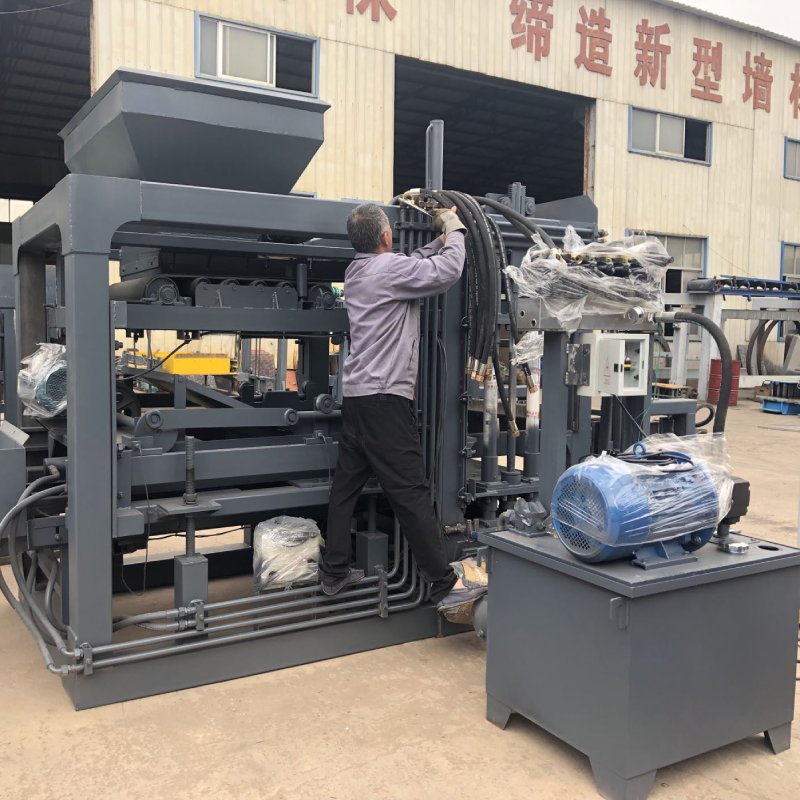
Image source Aiwei Block Machine
Revolutionizing Construction with Automated Brick Block Machines: A Comprehensive Guide
The Evolution of Brick Block Machines
To understand the significance of automated brick block machines, it’s essential to trace their evolutionary journey:
1. Manual Brickmaking
Historically, brickmaking was a labor-intensive, manual process. Workers would mold clay or concrete into bricks by hand, and then these bricks were sun-dried or fired in kilns.
2. Introduction of Hydraulic Presses
In the 19th century, the advent of hydraulic presses marked a significant advancement in brick production. These machines used hydraulic power to compress materials, significantly increasing production rates and consistency.
3. Emergence of Automated Machines
The mid-20th century saw the emergence of automated brick block machines. These machines incorporated conveyor belts, hoppers, and mold systems, reducing the need for manual labor and increasing production efficiency.
The Rise of Automated Brick Block Machines
In recent years, the construction industry has witnessed a surge in the adoption of automated brick block machines. These machines are equipped with advanced technologies that have revolutionized various aspects of construction.
1. Automation and Robotics
Modern automated brick block machines are equipped with robotic arms and sensors that handle tasks like material feeding, brick molding, and stacking. These robots operate with precision and speed, significantly reducing the need for human labor and minimizing the risk of accidents on construction sites.
2. Computer Numerical Control (CNC) Technology
CNC technology has been integrated into brick block machines, allowing for precise control of the manufacturing process. CNC systems can adjust machine parameters to produce bricks or blocks with consistent size and quality.
3. Internet of Things (IoT) Integration
IoT sensors and connectivity are being used to monitor and optimize machine performance in real-time. Manufacturers can remotely diagnose issues, track machine health, and collect data for predictive maintenance, minimizing downtime and improving overall efficiency.
4. 3D Printing Capability
Some advanced brick block machines are equipped with 3D printing technology, allowing for the creation of intricate brick designs and shapes that were once challenging or labor-intensive to produce. This capability opens up new possibilities for architectural design.
5. Energy Efficiency
Automation has also led to energy-efficient brick block machines. These machines are designed to consume less energy during production, contributing to cost savings and reduced environmental impact.
Applications of Automated Brick Block Machines
The applications of automated brick block machines extend across various sectors of the construction industry:
1. Residential Construction
Automated machines are used to produce bricks and blocks for residential buildings. The precision and speed of these machines make them ideal for meeting the demands of housing projects.
2. Commercial and Industrial Construction
Large-scale commercial and industrial construction projects benefit from automated brick block machines, which can produce a high volume of bricks or blocks efficiently.
3. Infrastructure Development
Automated machines play a crucial role in infrastructure development, including the construction of roads, bridges, and tunnels, where bricks and blocks are used for retaining walls and structural elements.
4. Architectural and Design Projects
The 3D printing capabilities of some automated machines make them valuable tools for architectural and design projects, enabling the creation of unique and customized brickwork.
Benefits of Automated Brick Block Machines
The adoption of automated brick block machines brings several significant benefits to the construction industry:
1. Increased Efficiency
Automation reduces the reliance on manual labor, leading to faster production and construction timelines. Projects can be completed more quickly and efficiently.
2. Improved Quality Control
Automated machines provide consistent results, ensuring that every brick or block meets high-quality standards. This results in more durable and reliable structures.
3. Safety Enhancement
Robotic handling of heavy materials and hazardous tasks enhances safety on construction sites. Human workers can focus on more skilled and less risky aspects of the job.
4. Cost Savings
Automation reduces labor costs, minimizes material wastage, and optimizes energy consumption, leading to overall cost savings for construction companies.
5. Design Flexibility
Advanced machines with 3D printing capabilities offer architects and builders greater design flexibility, enabling complex and artistic brickwork designs.
6. Environmental Sustainability
Energy-efficient and eco-friendly automated machines contribute to sustainability goals by reducing energy consumption and emissions during brick and block production.
Challenges and Considerations
While the benefits of automated brick block machines are clear, there are challenges and considerations that must be addressed:
1. Initial Investment
The upfront cost of acquiring and implementing automated machines can be substantial. Construction companies need to assess their budgets and weigh the long-term benefits against the initial investment.
2. Skilled Workforce
The transition to automated systems requires a skilled workforce capable of operating and maintaining these advanced machines. Training and education are crucial.
3. Technological Adaptation
Construction companies must adapt to new technologies and incorporate them into their workflows, which may involve changes in organizational culture and processes.
4. Regulatory Compliance
The adoption of automation may require compliance with safety and industry regulations, which can vary by region. Companies must ensure that they meet these requirements.
5. Data Security
IoT integration and data collection raise concerns about data security and privacy. Protecting sensitive information from cyber threats is essential.
The Future of Construction: Automated and Sustainable
The future of construction lies in automation and sustainability. Automated brick block machines are at the forefront of this transformation, redefining how buildings and structures are constructed. As technology continues to advance, we can expect even more innovations in construction, making it faster, safer, and more environmentally friendly.
The adoption of automation in construction is not just a trend; it’s a necessity. It enables the construction industry to meet the growing demands for infrastructure while reducing its environmental footprint and improving safety and efficiency. As we move forward, embracing these automated technologies will be key to revolutionizing construction and building a better future for all.
